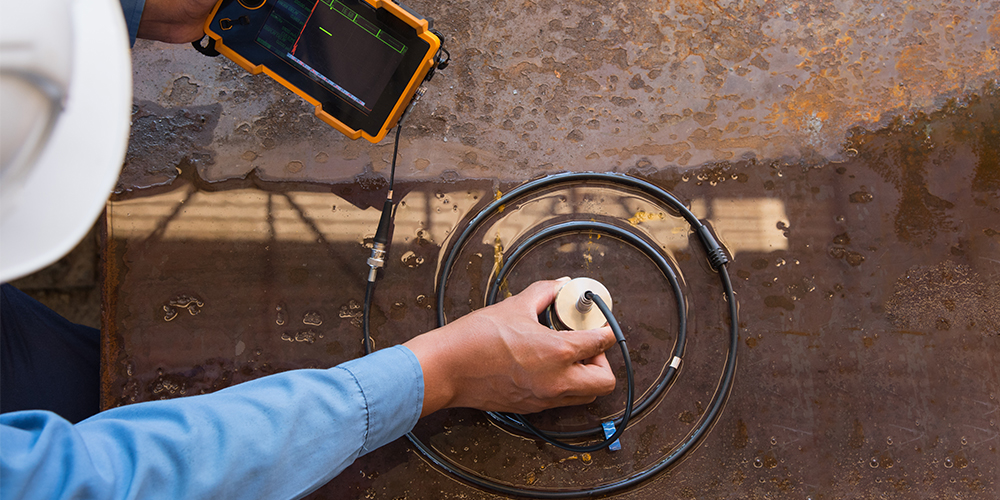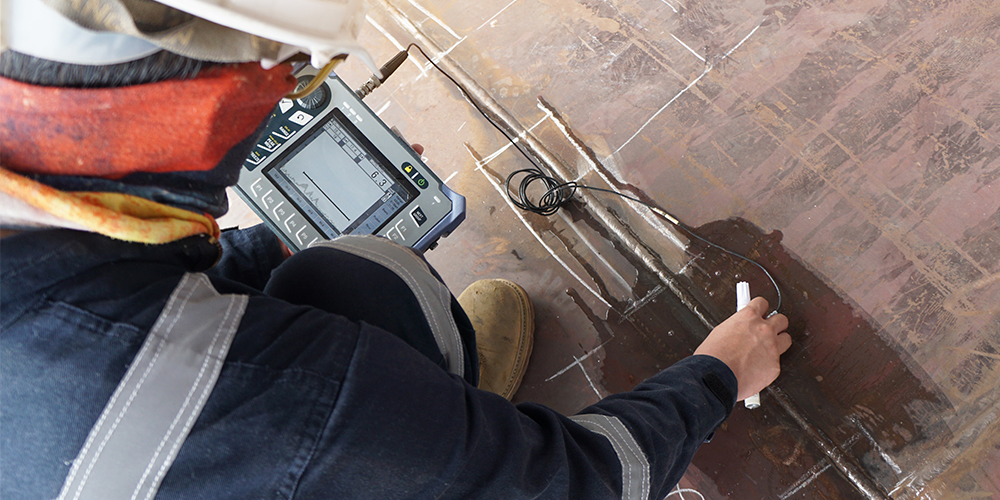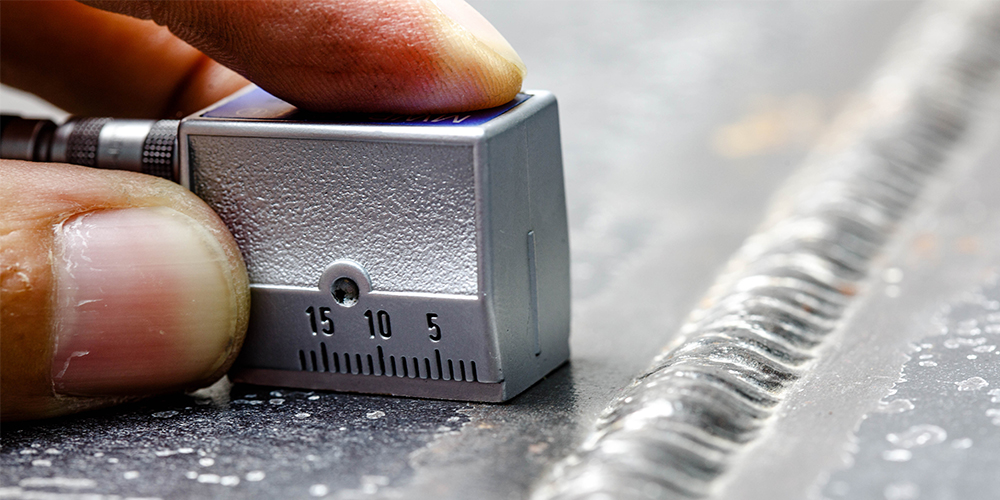The purpose of a good ultrasonic couplant is:
Because sound energy is affected by the density of the material it travels through, it does not travel well between air (low density) and solids (high density).
So, in order for the ultrasonic energy to get from the transducer (a solid), into the test piece (another solid), it is necessary to form a “bridge” across the space between the two solids for the ultrasonic energy to travel across. In many cases, an ultrasonic couplant is used to create the “bridge”.
The goal of selecting the right UT couplant is to maximize the amount of energy transmitted over the “bridge” while at the same time minimizing risk, cost, time, clean-up, etc.
In this article, we go over five questions to ask yourself and provide recommendations for each to help you select the best ultrasonic couplant for any application.

A part with a rough surface texture means a couplant has to do more work to create a reliable “bridge” for the ultrasonic energy to travel across. A thicker couplant will fill in the gaps and ridges on a rough-textured part better than a thin-watery couplant.
However, on smooth test surfaces, you don’t need a thick viscosity couplant. Here, a thin couplant is ideal for helping a transducer glide easily over the smooth or machined surface.
The key to any nondestructive test is that the material needs to be exactly the same after the test as it was before, this is why it is critical to use a couplant that is proven to not damage the test part in any way.
Unlike some non-spec approved materials commonly used as a couplant (such as high-temp grease, Vaseline, motor oil, hair gel, etc.), an NDT-couplant should have independent testing to guarantee it is safe to use on the material the part is made of.
Some couplants are better at corrosion inhibition than others, some couplants are safe to use on plastic and fiberglass, some are approved for aerospace alloys. Make sure you know what materials your couplant is approved for.
If the part or test area is relatively large, it is important to use a couplant that is self-leveling to minimize the amount of time spent applying the couplant.
Also, a couplant with good wetting characteristics will help ensure uninterrupted transmission during an UT inspection over a large test area.

Is the surface to be inspected horizontal, vertical, overhead?
For a vertical or overhead inspection, it is best to use a thicker couplant with a higher viscosity which will cling to test surface and provide a reliable bridge for the ultrasonic energy to travel through.
For high-temperature ultrasonic testing, it is important to use a couplant specifically formulated to hold up in high temperatures since a general-purpose couplant will not transmit ultrasonic energy at high temps and may burn or ignite.
When selecting a high-temp couplant, pay special attention to the auto-ignition temperature, which is the lowest temperature at which it will spontaneously ignite in a normal atmosphere without an external source of ignition, such as a flame or spark. Make sure to never use a high-temp couplant at a temperature above the auto-ignition temperature.
Additional special attention is needed when performing ultrasonic thickness readings with insulation. The action of the couplant mixing with the insulation creates a lower ignition temperature, so extra caution is needed in these applications.
Additionally, ultrasonic thickness readings are often in a "closed" environment where fumes or smoke may build up when the couplant begins to decompose due to heat exposure. This lowers the couplant’s flash point so you should not use a couplant at the upper end of its recommended temperature range in these situations. Always make sure to consult the couplant’s product data sheet before using it in a high-temperature application.
For ultrasonic testing in low temperatures, a water-based couplant is not the best choice because they are more likely to freeze when the temperature drops. A better option in low temperatures is to use a silicone- or glycol-based couplant. However, some water-based couplants can be “winterized” by adding propylene glycol to the couplant. Make sure to check with the couplant manufacturer before adding propylene glycol, or any other material, to a couplant.
Another consideration for UT inspections in extreme temperatures is that couplant viscosity will go up (get thicker) at lower temperatures and will go down (get thinner) at higher temperatures. So pick a couplant that will give you the desired viscosity during the inspection, which might mean picking a thicker or thinner couplant than you think you will need.

These types of ultrasonic testing usually only take a few minutes and are typically confined to a predetermined area so a wide range of couplants are compatible with these UT inspection applications.
This type of ultrasonic testing often involves high-temperature pipes or may require a couplant that is resistant to salt. This is because some of the thickeners used to control a couplant’s viscosity will degrade very quickly if used in the presence of salt (like on some bridges or boilers).
Long-term flow meter requires a couplant that will not dry out over time. For these applications, choose a glycol- or silicone-based couplant with excellent long-term corrosion protection properties.
A very thick, high-viscosity couplant is needed to couple shear waves since gel or liquid couplants do not support a shear stress. With such thick shear wave couplants, it is still recommended to use as thin a layer of couplant as possible.
Just like other types of nondestructive testing, many industry specifications have clearly defined requirements for ultrasonic couplants. Some of specifications with set couplant requirements are API, ASME BPVC and AWS.
Couplants used in UT inspections in the nuclear industry are required to meet very low levels of halogen and sulfur content.
Aerospace-approved couplants must be independently tested to guarantee they will not cause corrosion, stress cracking or hydrogen embrittlement on a wide range of metals, alloys and other materials.
Make sure to consider all the different parts you are responsible for testing and make sure to select a couplant, or couplants, which meet all specifications.
If you are inspecting a lot of parts, it is more important to select a couplant that is easy to apply and remove than if you are only inspecting a few parts since application and removal can impact the overall time spent on a UT inspection.
Some ultrasonic couplants are better than others at corrosion inhibition, especially over longer periods of time so make sure to use a couplant that meets your corrosion protection needs.
The key to finding the best couplant for your application is to balance price with performance.
For expensive, critical or precision components it is essential to use an NDT-approved couplant from a trusted manufacturer.
Making a change to any NDT process needs to be carefully considered, so it makes sense to spend a few minutes considering your current situation before you start looking for a new ultrasonic couplant.
A couple more questions you may want to ask yourself:
By considering where you are at now, you can evaluate whether a change is being made for the right reasons and you will be better equipped to make the right choice for your business.
Because, no matter what couplant you decide to use, you need to be confident in your NDT.
155 Harlem Avenue
Glenview, IL 60025, USA
Telephone: +1 847-657-5300
Contact Magnaflux Customer Service